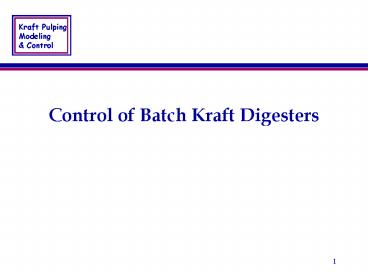Control of Batch Kraft Digesters - PowerPoint PPT Presentation
1 / 20
Title:
Control of Batch Kraft Digesters
Description:
Use PLS model to manipulate cooking time or temperature to achieve final kappa. 15 ... Continuous in-situ measurements of liquor EA (conductivity), lignin content (UV) ... – PowerPoint PPT presentation
Number of Views:140
Avg rating:3.0/5.0
Title: Control of Batch Kraft Digesters
1
Control of Batch Kraft Digesters
2
H-factor ControlVroom
- Manipulate time and/or temperature to reach
desired kappa endpoint. - Works well if there are no variations in raw
materials or chemicals.
Kappa orYield
15 EA
18 EA
20 EA
H-factor
3
H-factor ControlVroom
4
Kappa Batch ControlNoreus et al.
- Control strategy uses empirical model that
predicts kappa number from effective alkali
concentration of liquor sample at beginning of
bulk delignification (150 ºC). - Where H is H-factor, EA is effective alkali, K is
kappa number, and a are model constants.
5
Kappa BatchSensors
- Effective Alkali Analyzer - Conductivity
Titration - Temperature and pressure sensors
6
Kappa BatchLaboratory Tests
- Effective alkali compared against titration
- End of cook kappa to check prediction
7
Kappa BatchDisturbances/Upsets
- Chip Supply
- Moisture content, size distribution, chemical
content - Pulping Liquor
- White liquor EA and sulfidity
- Black liquor EA and sulfidity
- Digester Temperature Profile
- Time to temperature and maximum temperature
8
Kappa BatchOperations and Objectives
- Operator Setpoint(s)
- End of cook kappa number
- Manipulated Variables
- Temperature profile
- Cooking time
- Control Objective
- Decrease standard deviation in final kappa
target.
9
Kappa BatchMill Results
- Lowered final kappa standard deviation.
10
Kappa BatchControl Benefits
- Bleached Pulp
- Lower chemical usage and effluent loading in
bleach plant - Unbleached Pulp
- Higher yield
11
Batch ControlKerr
- Control strategy uses semi-empirical model that
predicts kappa number from effective alkali
concentration of liquor sample taken at two
points in the bulk delignification phase. - Where H is H-factor, a2 and b2 are slope and
intercept of lignin to EA relationship, a3 and a4
are constants (a3 can incorporate sulfidity and
chip properties).
12
Batch ControlKerr
13
Inferential ControlSutinen et al.
- Control techniques use liquor measurements (CLA
2000) for control of final kappa number - EA conductivity
- Lignin UV adsorption
- Total dissolved solids Refractive Index (RI)
14
Inferential ControlSutinen et al.
- Statistical model using Partial Least Squares
(PLS) to predict kappa number. - Past batch information used to formulate current
control model. - Control Strategies
- Use PLS model to manipulate cooking time or
temperature to achieve final kappa
15
Inferential ControlModel Results
- Using model final kappa variation reported to be
reduced by 50.
16
Inferential ControlKrishnagopalan et al.
- Statistical model using Partial Least Squares
(PLS) to predict kappa number. - Past batch information used to formulate current
control model. - Control Strategies
- Direct Use PLS model to manipulate input vector
- Indirect (adaptive) Use PLS model to estimate
parameters of empirical model for control (e.g.,
Chari, Vroom) - Kinetic models developed for lignin,
carbohydrates, and viscosity can be used for
optimization (e.g., liquor profiling).
17
Inferential Batch ControlSensors
- Continuous in-situ measurements of liquor EA
(conductivity), lignin content (UV), solids
content (RI), and sulfide concentration (IC). - Measurements are also done using near infrared.
18
Inferential Batch ControlOperations and
Objectives
- Operator Setpoint(s)
- End of cook kappa number
- Manipulated Variables
- Midpoint temperature
- Cooking time
- Control Objective
- Decrease standard deviation in final kappa target
19
Inferential Batch ControlOperations and
Objectives
- Model based control adjusts both end time and
temperature in optimal fashion. - Temperature main manipulated variable
20
Inferential Batch ControlSimulated Results
- Adaptive strategy performs better. Handles
non-linearity between manipulated variables and
end kappa more efficiently.































